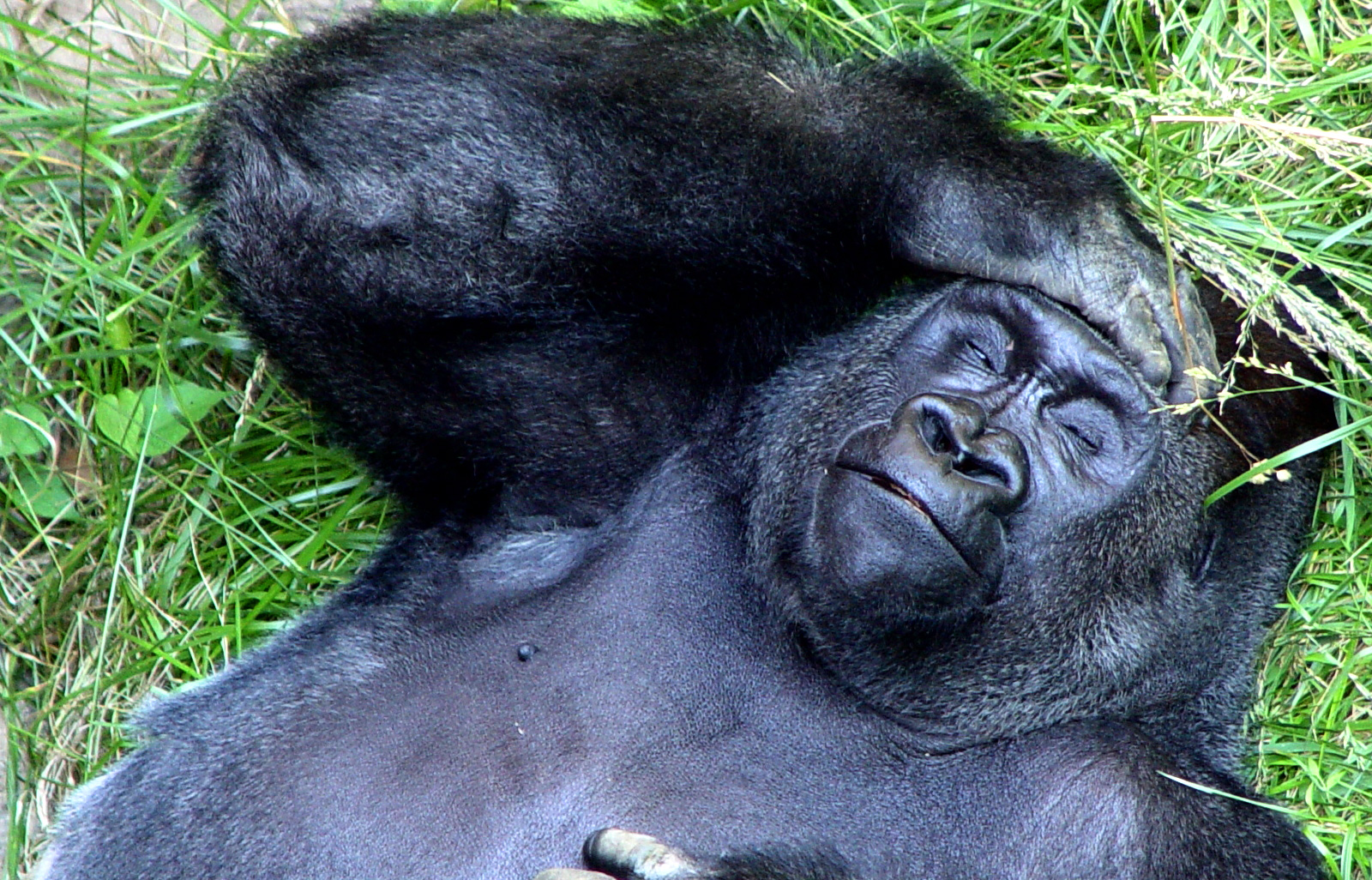

Larger bands consist of an adult male, several younger males and a large number of females with their young. Gorillas live in fairly stable groups of 5 to 15 individuals. Very often other females will play the role of "aunt" to a baby and participate in its care, playing with it and carrying it around. Juveniles climb more frequently and with greater ease than the adults. By one month, the infant clings to its mother unaided by three months it rides on its mother's back by four or five months it can walk unaided, by six months it can climb and is very active. It begins to eat vegetable matter at about six weeks of age, but nursing continues for another year and a half to two years. When on the move, she cradles the infant to her breast with one hand. At birth they appear to lack the strength to grasp their mother's hair, so she will support her infant with both hands. The baby gorilla is completely dependent on its mother for food and protection. A single young is born weighing approximately two kg. The average gestation period is 265 days. Female gorillas have a menstrual cycle similar to that in humans, the average length being 30 - 31 days. In male apes, including humans, potency (the ability to sire offspring) is continuous until it is lost through senescence. This usually occurs between the ages of 15 and 20 years. The dominant male, because of his perceived superior fighting ability, is preferred by the females as he will be better able to protect them and their offspring. Typically one dominant male within a gorilla troop mates with the females in that group. Females begin breeding as soon as they are sexually mature, but male gorillas need to physically mature so they can attain silverback status and lead a group of gorillas. Males are sexually mature at about 10 years of age and fully grown at 12 - 15 years. The face, ears, palms and soles of the feet are bare.įemales mature sexually around 8 years of age and are fully grown at 8 - 10 years of age. As a male gorilla reaches physical maturity (between 12 and 15 years of age), he develops his silvery grey colouration giving them the name “silverback”. The colour of the coat varies considerably, ranging from black, silver and shades of red. The muscular arms are longer than the short thick legs, and the broad hands are equipped with short fingers and thumbs. The nostrils are large and flaring, the ears small and close to the head, the eyes are wide set and expressive. The heavy muscled head and shoulder area of the adult male is what really identifies him in the wild from the female when only the head is showing. The male’s crest is more prominent than the female’s.

Gorillas develop a “sagittal crest” which is a ridge of bone on top of their head. The females are much smaller and slimmer. The male is very stocky and powerful in the body, with wide shoulders and chest. The males, on average, weigh approximately 135 - 220 kg and the females weigh about half of that, around 70 - 90 kg. Western lowland gorillas are the smallest of the four sub-species. Gorillas are the largest of the primates. The western gorilla subspecies are the western lowland gorilla (Gorilla gorilla gorilla) and the cross river gorilla (Gorilla gorilla diehli). The eastern gorilla subspecies are the mountain gorilla (Gorilla beringei beringei) and the eastern lowland gorilla (Gorilla beringei graueri). Within each species there are two subspecies. Therefore an adult male cannot wrestle and win against a wild silverback gorilla, which instinctively learns to fight other silverbacks in the battle for dominance.There are two species of gorilla: the western gorilla (Gorilla gorilla) and the eastern gorilla (Gorilla beringei). How powerful is a silverback gorilla in comparison to a human or an adult man?Īn average silverback gorilla is at least seven to 18 times stronger than an adult male. Silverback gorillas typically weigh 135 to 195 kilograms (300 to 430 pounds) and stand 1.5 to 1.8 meters (4 feet 11 in to 5 ft 11) tall with an arm span ranging from 2.3 to 2.6 meters. This is done to demonstrate their surrender to the silverback. When the silverback gorillas do this, the nearby adult females, youngsters, and babies cuddle together, their bellies to the ground and their feet and hands wrapped beneath their bodies.

This could be a sort of play, an attempt to intimidate, or merely to warn the group that there is something unique going on, or it could simply be the start of an encounter. Normally, hibernating silverback gorillas charge, pounding their chests and howling. Silverback gorilla Why does a silverback charge?


 0 kommentar(er)
0 kommentar(er)
